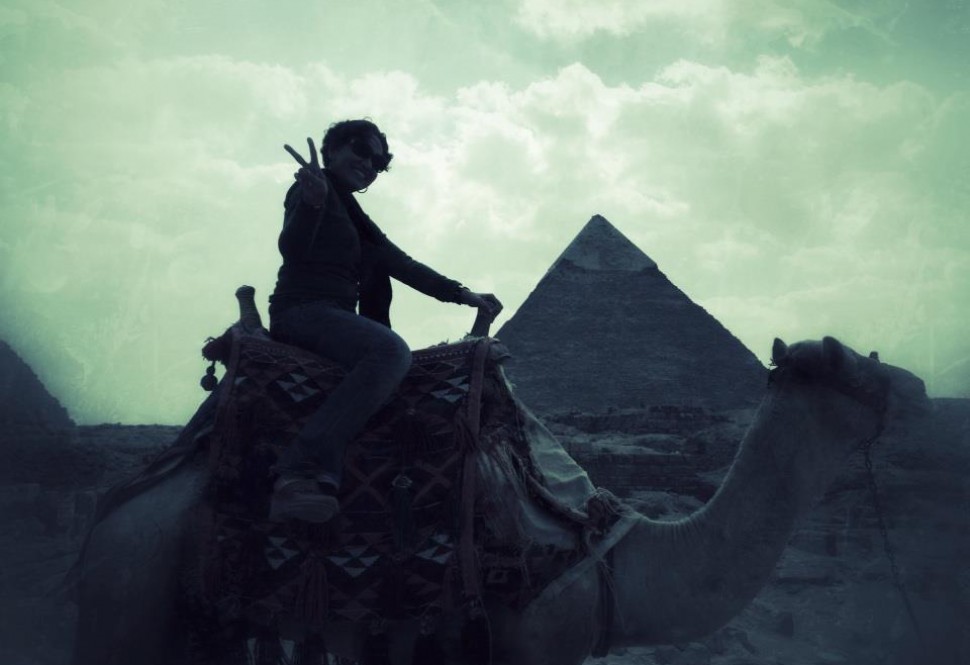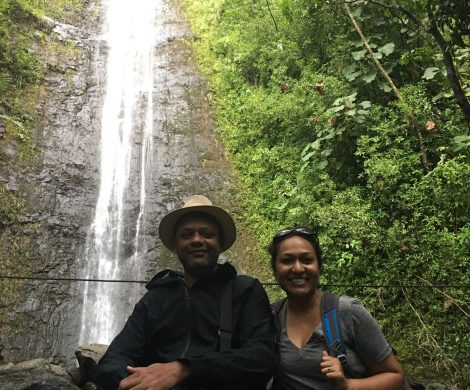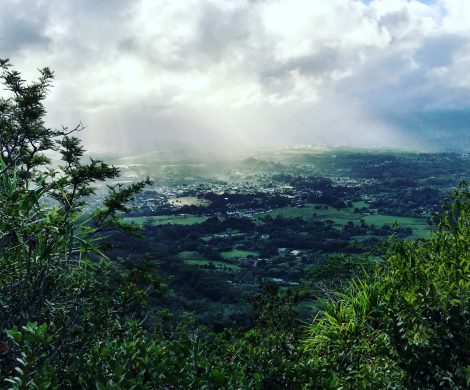
I visited Cairo in February of 2013 during a period of uncertainty in Egypt. The Egyptian Revolution, apart of the Arab Spring had managed to oust Hosny Mubarak from power in 2011. The Muslim Brotherhood had taken over the government and Mohamed Morsi had been elected President just 6 months prior to my arrival. While things had calmed down to some extent, murmurs of unrest were being heard and a grassroots movement was taking shape against Morsi’s increasing authoritarianism and predominantly Islamist agenda. Six months later, in June 2013 in a coup d’état Morsi would be removed.
As usual, I was visiting on business, and despite the prevailing circumstances, was determined to visit the Pyramids of Giza. Tourism was still very light, though Egyptians went about their business as usual. The infamous traffic jams all over Cairo were a testament to that.
One afternoon after my meetings, two local business associates took me on the hour-long drive from downtown Cairo to the Giza suburb.
The Giza Pyramid Complex is about 18 kms from Downtown Cairo across the Nile River and is typically a 30 min drive. But this is Cairo and the traffic is always a nightmare, so be prepared for the journey to take anywhere between 60-90 minutes.
The first thing that struck me and frankly, surprised me was the proximity of the Giza Pyramid Complex to civilization. I had this romantic notion of the Pyramids being deep in the desert someplace. So, imagine my shock at looking out of the car window on a busy street in Giza and finding the Pyramid to my left, with cars, commercial buildings and electric poles in the foreground.

On one side of the pyramids you see the desert and on the other side a residential neighborhood. Across the street from the main gate to the pyramid complex is a Pizza Hut! That is literally what the Sphinx is looking at.
Much has been said and written about the Pyramids, so I won’t go into any detail about its history or significance. Here’s a Wikipedia entry with all the details.
What I do want to describe here is my personal experience of the visit and my disappointment at the horrible mismanagement of this last surviving wonder of the ancient world.
Not so great entrance to the Great Pyramid
The entrance to the Pyramid Complex is overrun by touts and trinket vendors trying to con unsuspecting tourists. As you enter the place in a car, you are surrounded by a swarm of young Egyptian men banging on your car window, door, hood….whatever they can, trying to tell you that you cannot enter in your car and have to take a camel or a horse. This is of course not true, but there are no security guards around and no one to enforce any form of order.
There are no signages, information boards or trash cans anywhere in sight. There’s litter all over the place, and aggressive camel riders trying to sell you their services in annoying ways. An overwhelming stench of horse dung and camel urine permeates the air. The few tourist police I did spot at a distance inside the complex seem to be in cahoots with the touts.
Luckily, I was with two tall, well built Egyptians who took care of everything for my visit. Because they were locals, and spoke Arabic we didn’t have to deal with the usual level of harassment other tourists experience.
Camel Ride

My friends asked me if I wanted to ride a camel, and mostly out of curiosity I agreed. I ended up on a particularly grumpy fella who kept grunting and trying to shake me off, even as the camel guy tells me – Take nice photo, very nice!
I probably lasted less than 5 mins on the camel, and was glad to get off it.
Near the camel ride place is also one of the best spots to get a picture of the Great Pyramid in the background.
Into the Desert
From this spot, you need to go into the desert to get to the Pyramids and this can be done on horseback (or camel if you are brave enough!). I fared much better on the horse, than I did on the camel. We rode on horseback around the desert with the tour guide, looking at the other pyramids and eventually reached the Great Pyramid, also known as the Pyramid of Khufu.

The tour guide told us there are 3 large pyramids and 60 smaller ones all over Giza. The other large pyramids we passed are the Pyramid of Khafre, the Pyramid of Menkaure, and the smaller Queen’s Pyramid, which mostly looked like a neglected pile of rocks.
The Great Pyramid of Khufu
Khaled, my Egyptian friend told me to hand over my bag to our other friend if I wanted to go inside the Great Pyramid. I couldn’t understand why at the time and wondered why the second guy was not joining us to go inside.
That became clear 5 minutes later when I entered the Great Pyramid of Khufu!
The main entrance to the great pyramid is now closed. The present entrance, known as the Robber’s Entrance is at a lower level from the ancient main entrance, but still at a height of 17 meters. It’s a narrow space created literally by removing 2 stones from the face of the pyramid.


Once again, going with a local came in handy because an Australian group was scheduled to enter the Great Pyramid at 4 PM and it was 3:45 PM. Khaled spoke to the guard at the Robber’s Entrance in rapid Arabic, money exchanged hands and we were given exactly 15 mins to get to the top and back! So, it was just the two of us, which made things easy and fast.
While the Great Pyramid houses several chambers, entry is only allowed to the King’s Burial Chamber. As we entered the Robber’s Entrance, I finally understood why Khaled had insisted that I enter unencumbered and why our other friend had decided not to enter.
 If you are claustrophobic, going inside the Great Pyramid is not for you. You have to go through a long, narrow passageway that turns abruptly into corners with seemingly tiny openings that it feels almost impossible that there might be another passage there. These passages are about 3.1-feet high and 3.4 feet wide and you have no choice but to go in a single file. Entrance is restricted by numbers, and if a group is already inside, another group will not be allowed in because the new entrants will block the only exit passage for those returning from the King’s Chamber. If you have decided to go in and get cold feet half way, you cannot turn around. It’s simply not an
If you are claustrophobic, going inside the Great Pyramid is not for you. You have to go through a long, narrow passageway that turns abruptly into corners with seemingly tiny openings that it feels almost impossible that there might be another passage there. These passages are about 3.1-feet high and 3.4 feet wide and you have no choice but to go in a single file. Entrance is restricted by numbers, and if a group is already inside, another group will not be allowed in because the new entrants will block the only exit passage for those returning from the King’s Chamber. If you have decided to go in and get cold feet half way, you cannot turn around. It’s simply not an
Entrance is restricted by numbers, and if a group is already inside, another group will not be allowed in because the new entrants will block the only exit passage for those returning from the King’s Chamber. If you have decided to go in and get cold feet half way, you cannot turn around. It’s simply not an option, because there is no space for you to go back if there are people behind you.
It’s easy to lose your footing on the uneven surface and it’s advisable to hold on to the thick iron bars on the sides. You’ll mostly be crouching low as you try to make your way forward. Towards the top, there are no clear steps…just tiny wooden foothold things, and the iron railings on the side for support.
The passageway leads to a rectangular room known as the King’s Chamber, which at one time was the tomb of the Pharaoh Khufu. His mummified body was kept in a sarcophagus along with jewelry, ornaments and all those things the ancient Egyptians believed the Pharoah might require in the afterlife!
Today, of course, the room is empty and except a granite sarcophagus, there was nothing else in it. After the adventure of having climbed and crawled through a narrow passage to reach this spot, I was quite underwhelmed by the King’s Chamber.


We took a few quick photos of the descending passageway from the top, which made us realize how high we had climbed, and how narrow the passageway was! Given our time restriction, we had to start our descent almost immediately and we made it out panting and sweating, but with an adrenalin rush, and happy to inhale fresh air and see wide open spaces again! The entire adventure took us 20 minutes and the Aussie group was already getting antsy.
The Mysterious Sphinx
By the time we got done with our Pyramid adventure, it was too late to visit the base of the Sphinx, but I did manage to pass by it on horseback and take a romantic sunset photo!
The Great Sphinx sits to the northeast of the Pyramid of Khafre at a site that was once a quarry. The Sphinx is a composite of a lion’s body with a human face. There is a causeway connecting the Sphinx to the causeway of the Pyramid of Khafre, which leads many to believe the face belongs to the Pharaoh Khafre and might have been constructed by him.

It is the largest monolith statue in the world, and perhaps the most mysterious. The nose of the Sphinx is chipped off and the statue is a magnificent ruin that hasn’t aged well. Thieves have plundered its stones, and desert winds have eroded its limestone structures.
The Sphinx on three occasions was found buried in sand. It was first dug out by an ancient king, then by Napoleon Bonaparte and finally by an explorer at the turn of the 19th century. Many restoration projects have been undertaken to preserve it.
After all these millennia, the Sphinx is yet to reveal its secrets to the world.
The Papyrus Museum
Our guide told us we should visit the papyrus museum as it’s just across the street from the Sphinx. Museum is obviously an exaggeration because this turned out to be a Papyrus shop, owned by perhaps Egypt’s best salesman!
When I told him I was Indian, he insisted I sing a song from the movie Sangam, drink a cup of Egyptian tea and watch him make the Papyrus from the stem of the papyrus plant. The demo was indeed interesting and he was a brilliant storyteller. Of course, at the end of it, he offered me a ‘very good price‘ for the Papyrus paintings, displayed all over the shop, which he had painted himself.
Once that sale was made, he brought us down to his ‘perfumery’ where bottles of natural essence from flowers are stored and went on to explain how he exports to pretty much all the perfumeries in France, including all the big designer brands. He gave us each a complimentary glass oil diffuser as we finally left his shop!
Traveler Tips
I was lucky to have visited Giza with locals and hence didn’t have to deal with the numerous touts and scam artistes. But they are everywhere! Remember, nothing is free, however innocently offered. Avoid eye contact with the touts, bargain like crazy with the camel riders, and never accept anything a vendor hands you to ‘just see’. He will demand that you pay for it and turn nasty when you try to hand it back.
It’s a shame that the Government has done nothing to upgrade the facilities and treat its #1 tourist attraction with more respect. Egypt has the last remaining ancient wonder of the world in its backyard and yet it treats it with such shocking carelessness.







